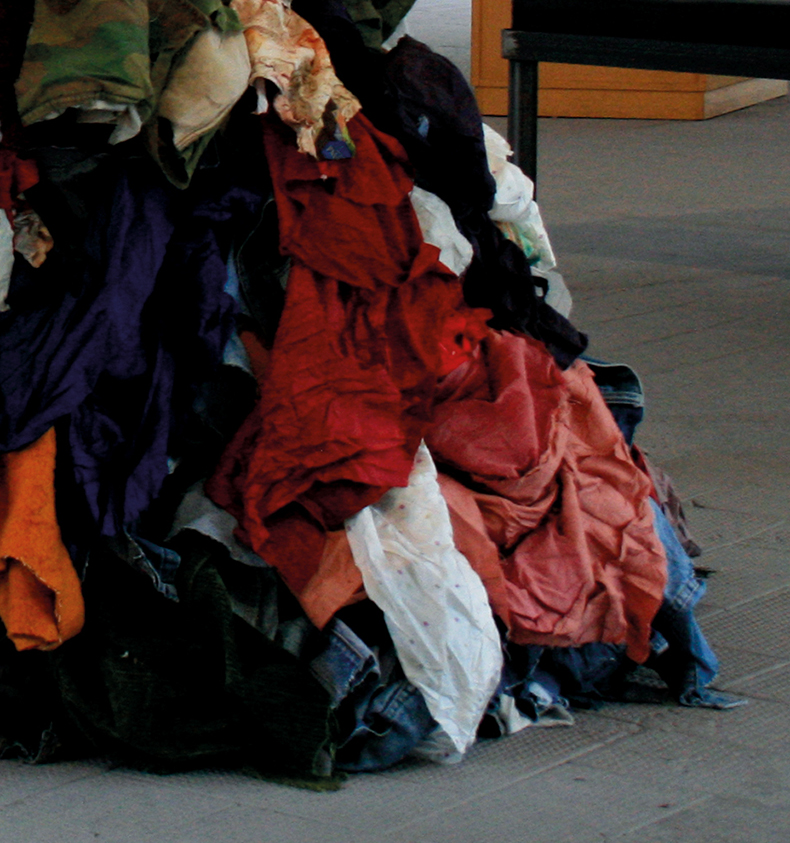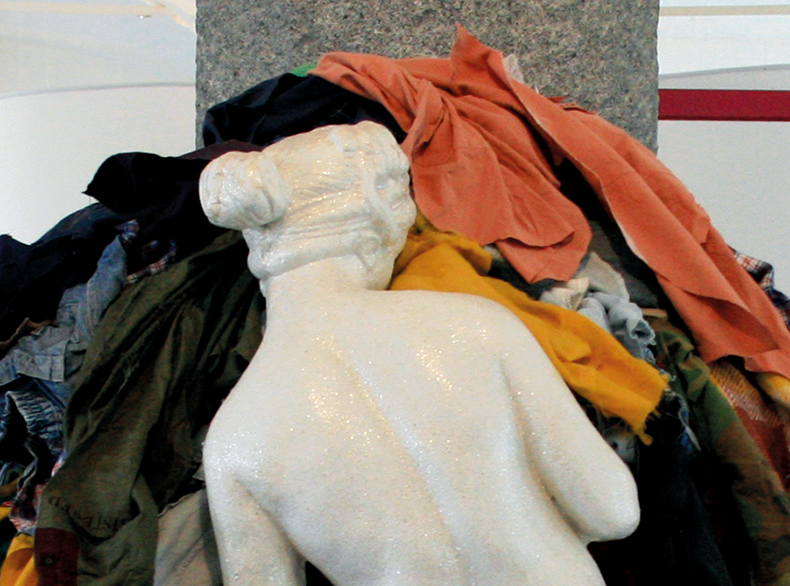From the October 2024 issue of Apollo. Preview and subscribe here.
Arte Povera, or ‘poor art’, is the name given to a group of artists and their work that was made in Italy in the 1960s and ’70s. The name comes from the types of materials that they worked with, from soil and twigs to rags and rubbish. Michelangelo Pistoletto (b. 1933) is probably the best known of the Arte Povera artists and his Venus of the Rags is perhaps the group’s masterpiece. It was created in 1967 in Pistoletto’s studio in Turin and what is important to know is that at the time, Pistoletto’s studio, which opened in 1965, was almost an artist-run space, like an exhibition space. When he had his show at Sperone Gallery in 1966 he just put a sign up at the gallery saying, everything’s happening at my studio, come by. The work was first shown in public at the landmark exhibition ‘Vitalità del negativo nell’arte Italiana’ (‘Vitality of the negative in Italian art’), curated by Achille Bonito Oliva at the Palazzo delle Esposizioni in Rome in November 1970. But the work was widely known from having been exhibited in Pistoletto’s studio in 1967.
This was a key year for the development of Arte Povera as a group. I don’t use the word ‘movement’ because you have to have an artist naming the movement as a movement, like André Breton; you have to have a manifesto. Movements are much more associated with early 20th-century avant-gardes or, at the latest, art movements of the 1950s and early ’60s. Arte Povera was a loose affiliation of artists, of whom Pistoletto was one of the earliest. The two oldest were Mario Merz [1925–2003] and Marisa Merz [1926–2019], followed by Pistoletto, who is now 91. It was actually Pistoletto who made a connection with the international art world, along with Piero Gilardi (1942–2023), showing with Sonnabend Gallery in Paris early in his career, in 1963.
The version of this work that is being exhibited at the Bourse de Commerce as part of ‘Arte Povera’ (9 October–20 January 2025) is one of the first three that Pistoletto made, and the first one to be shown in his studio. You can tell it’s this version because the sculpture of Venus has mica mixed in with the plaster, so it resembles white gesso but slightly shiny, and if you look closely you can see the light picking out the mica in the mixture. There is, of course, a connection between the mica in the sculptures and the mirrors that Pistoletto used as the ground for his most famous paintings.
Venus of the Rags, as constructed in the studio of Michelangelo Pistoletto. Photo: Enrico Amici; courtesy the artist/Luhring Augustine, New York; © the artist

The statue itself is a copy of Venus with the Apple by Thorvaldsen, from 1813–16. So the original is a neoclassical work, itself a copy of a classical work. But even the classical work is based on the lost Aphrodite of Knidos by Praxiteles from the fourth century BC, known only from the many Roman copies. Pistoletto just bought a copy of Thorvaldsen’s Venus with the Apple from a garden shop, just a cheap piece of plaster cast sculpture, so we are really talking Arte Povera.
Pistoletto is not the only Arte Povera artist to use plaster cast sculpture in their work. Giulio Paolini (b. 1940) frequently used plaster casts of historical sculptures in works such as Mimesi (1975), which has two plaster cast sculptures looking at each other. I always smile when major people in the art world adore something because there’s this sculpture that looks like a classical Greek or Roman sculpture, and it’s actually just a garden sculpture or an art school plaster cast. It’s funny, but it was a radical gesture at the time to go against the figuration of Pop art in the 1960s. It is saying something closer to what de Chirico was saying in the early 20th century with his variants, which anticipate Andy Warhol and the many copies of Marilyn. Warhol recognised de Chirico as a master preceding him with the idea that there isn’t really an original any more, there are only copies of copies of copies in our world. Viewed through the lens of Arte Povera, this becomes a very democratic kind of a statement: it’s a poor object. It’s a sculpture that anybody can have.
The sculpture is also the still part, the immobile section of the work, while the mobile part of the work is the rags. If you think of Pistoletto’s Quadri specchianti, his Mirror Paintings, there is a still image on top of the mirror while the reflection moves. Pistoletto always talks to me about the fact that the rags move. The rags are like many people arriving in front of a Mirror Painting, with the clothes being incorporated into the mirror. This work is a transformation of the Mirror Paintings into solid materials in space. When you move Venus of the Rags, you always have to reinstall the rags. You’ll never get the rags the same. It has that dynamic vitality of metamorphosis of the background mirror in a Mirror Painting.
Detail of Venus of the Rags , as constructed in the studio of Michelangelo Pistoletto. Photo: Enrico Amici; courtesy the artist/Luhring Augustine, New York; © the artist

These rags are one of the first uses of an ecological proposition. By which I mean, if you think about ecology as recycling, this is one of the first artworks that involves recycling. It is not about appropriation of some large or found objects that are old, and it’s not about recovering trash and just putting it in a collage, like in a Daniel Spoerri table; it’s about recycling materials and making them new again. It is not by chance that Pistoletto became a very strong environmentalist, with his concept of ‘the Third Paradise’, of a balance between the natural and the artificial. That is the only way that we can move forward on the planet.
Why is there a still element and a moving element? The most important painting for Pistoletto in all of art history is The Flagellation of Christ by Piero della Francesca, in Urbino. He saw that painting when he was 18 years old, with his father, who was an art restorer. An art restorer and his son, Michelangelo, helping him – it is no accident the art restorer called his child Michelangelo. Piero’s painting is divided into two parts: in the right-hand part, you have a scene of three people talking – it’s really the aristocrat, the man who commissioned the painting, talking with two people, and they’re lifesize. There is no flagellation at first glance. When you look carefully, on the left-hand side, in the deep recess of the painting, you see Christ being whipped by Roman soldiers. Piero della Francesca is saying that the most important events are sometimes the smallest things that nobody notices. Pistoletto had an epiphany when he saw that painting: he understood that if you look in a mirror you see yourself reflected immediately, but if you have a still image on the surface of a mirror that doesn’t happen, because the surface only sends back the image of the still painting that has been applied to it. The question is, where are you in the image? When you look at a Mirror Painting by Pistoletto with something glued on the mirror, you are not with the image on the surface reflected back, but rather you are captured in the deep recess of the work. You’re behind the person who is in the foreground on the surface. By putting together a still element which combines and interacts with a moving element, which is the glass, or – in the case of Venus of the Rags – the rags, you don’t become simply a detached modernist observer of a pile of rags. You somehow enter into the rags. You’re part of the rags, with your clothes, by contrast with the Venus.
There are many versions of this work. Pistoletto always dates his Venuses ‘1967– the date of execution’ – this is typical of Arte Povera, because for Arte Povera artists the first execution of a work is like the concept, and that must always be recorded in the date. But it is not just the concept, it is the first material realisation of that concept, and in a way, every other version is like another incarnation of the same work. It’s like an organism that develops through time, and so each artwork is alive. I remember Mario Merz used to tell me that his igloos appear and disappear, but it is always one igloo for him.
Detail of Venus of the Rags , as constructed in the studio of Michelangelo Pistoletto. Photo: Enrico Amici; courtesy the artist/Luhring Augustine, New York; © the artist

At a more practical level, the only instruction for installing the work is that you have to place the Venus facing the rags so you don’t see the apple – though in Thorvaldsen’s work the apple is the whole point – so the apple is hidden and the rags are in a kind of a mound. But the question of installing Arte Povera goes beyond Pistoletto: it is a major question and a major challenge for the future, because it is like playing music. If you have a Beethoven score it can sound very different according to whether it is played in one historical period or another, or, indeed, by one pianist or another; a symphony can sound one way with one conductor and different with another. For me, the curators of the future are like conductors and the pianists are the installers of the works. At the moment we have a legacy of people who are or were the assistants of the artists and who have inside knowledge of how to install Arte Povera works such as Venus of the Rags; many of them work with the company Attitudine Forma, which is like a co-op of expert installers. When I install a work by Pistoletto it is as though I am the conductor and someone from Attitudine Forma is the pianist. The company was founded by four men, Roberto Dipasquale, Filippo Di Giovanni, Antonio Zaccone and Roberto Fioccardi, and they have talked to younger installers such as Leo Quartucci, to pass on their knowledge. Tragically, Fioccardi died recently, and with him some things are lost, because he didn’t have a chance to teach them. It was a great loss. He was only 61. He just went into the hospital for a routine operation and didn’t come out.
There are other expert installers, such as Alessandro Lascirasella, Mariano Boggia, Rocco Mussat Sartor, Damiano Urbani, and more, each one an expert in the installation of the work of one or more artists. We are trying to learn as much as possible from Michelangelo Pistoletto, Pier Paolo Calzolari, Giuseppe Penone, Giulio Paolini and Gilberto Zorio, since they are members of the Arte Povera group who are alive and with us. It is extremely important that this legacy carries on from one generation of installers to another.
Venus of the Rags (1967), Michelangelo Pistoletto. Castello di Rivoli, Turin. Photo: Paolo Pellion; courtesy and © the artist

The last time I installed this work was in the Manica Lunga at Castello di Rivoli, and I had my ‘pianist’ come along and we did it. We looked at many photographs of successful installations, but we never try to reproduce the colours. You don’t put one rag after another, you just bunch them together. You don’t replace the rags; we keep the originals. They might be washed occasionally, every ten years or so in a normal washing machine, but under the supervision of our restorers. But they need to be washed. You can’t just vacuum – you can’t conserve them in the way that you would take care of a 19th-century painting. They’re in containers that compress them and so they come to life as you bunch them up and then create the work. They must be arranged symmetrically and the Venus must be in the centre. And you have to push the statue in a little bit, you have to feel the tension – it mustn’t just be near the rags. At this stage Pistoletto comes in and he will comment, ‘Oh, I don’t like it. It needs to be higher, a little bit taller, little bit wider.’ He says that, I think, not because it’s an autonomous artwork and it always has to be exactly his way, but because he’s feeling it phenomenologically in that space. So in a certain space it might be two centimetres higher, in another space it might be two centimetres lower. It depends on the space, and you have to feel it with your body.
At the heart of the problem of installation is a question about whether Arte Povera will be able to be itself in 100 years. I hope that it will, but that will happen only if people are humble and understand that it is being installed without the artist and you must also have someone who has known someone who has installed it; it is a legacy. Sometimes, looking at a particular version of Venus of the Rags, you can see immediately that it was installed by somebody who has no idea – it’s just a mound of cloth and a gesso sculpture. What is missing is the energy of Arte Povera, and Arte Povera is all about energy.
As told to Edward Behrens.
Carolyn Christov-Bakargiev is the former director of the Castello di Rivoli and is working on Michelangelo Pistoletto’s catalogue raisonné.
‘Arte Povera’ is at the Bourse de Commerce Pinault Collection, Paris, from 9 October to 20 January 2025. (www.pinaultcollection.com)
From the October 2024 issue of Apollo. Preview and subscribe here.


